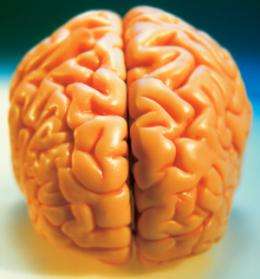Repeated stress produces long-lasting resistance to stroke damage in the brain

(PhysOrg.com) -- An innate protective response that makes the brain resistant to injury from stroke can be made to last for months longer than previously documented, researchers at Washington University School of Medicine in St. Louis report.
The inducible protective phenomenon, called tolerance, typically lasts only a few days. Washington University scientists have now induced tolerance lasting for at least two months in adult mice. Researchers say the results suggest that this new kind of tolerance, which they were studying for its potential to reduce brain injury from stroke, may actually be applicable to a variety of neurodegenerative conditions, such as multiple sclerosis, Alzheimer’s disease and amyotrophic lateral sclerosis.
The key to turning on tolerance in the brain is positively stressing tissue without harming it, a process called preconditioning. Washington University scientists extended tolerance to two months by repeating the preconditioning stimulus — in this case, exposure to low oxygen — every other day for two weeks prior to a stroke. The results appeared online March 17 in Annals of Neurology.
“Stress has negative connotations for most of us, but the right kinds of stress, or stress patterns, can actually promote beneficial responses in cells and tissues without causing any harm,” says Jeffrey M. Gidday, PhD, associate professor of cell biology and physiology, of neurological surgery and of ophthalmology and visual sciences. “If we can learn how these positive effects are created by nature, we might be able to pre-treat patients who are at high risk of stroke, and thus significantly reduce brain injury if a stroke occurs. We might also be able to use tolerance to slow the advance of chronic neurodegenerative diseases.”
The German philosopher Friedrich Nietzsche once asserted, “That which does not kill us makes us stronger.” Scientists have spent more than two decades exploring the biological validity of this axiom. Positive stress, such as exercise or brief periods of low oxygen exposure, temporarily makes cells in the brain, heart and other tissues of the body more resistant to damage. Investigations of preconditioning in the heart have led to clinical trials, now under way, to evaluate tolerance's potential for reducing damage from heart attacks.
When researchers create strokes in mice where tolerance has recently been induced in the brain, damage from the stroke is greatly reduced. After a stroke, tolerant brain cells are much less likely to undergo apoptosis, die from a form of overstimulation known as excitotoxicity or suffer damage from inflammation or chemically reactive compounds called free radicals.
Gidday describes preconditioning-triggered tolerance as the “opposite side of the coin” of apoptosis, a built-in suicide mechanism in cells that is triggered by damage to DNA and other molecules.
“Instead of programmed cell death, this is programmed cell survival,” he says. “If you stress a cell in the right way, it changes which genes the cell uses, putting the cell into a robust protective mode where it's more resistant to all kinds of injury.”
Gidday speculates that the two-month duration of extended stroke tolerance in mice, which only live two to three years, could mean that a similar phenomenon in humans might last six months or more.
For clinical treatments, he envisions a pharmaceutical agent that can trigger some of the same gene activity changes triggered by repeated low oxygen preconditioning. Tolerance does not develop quickly enough to be a treatment for an acute stroke, or for other unpredictable injuries like a bursting aneurysm or head or spinal cord trauma. Instead, Gidday and others hope to see sustained tolerance induced in patients already identified as being at increased risk for stroke and other neurological conditions, providing these individuals significant protection should the injurious event occur.
Gidday’s team is currently attempting to learn which genes have altered activity levels in tolerant brains, including those in brain blood vessels. They are also exploring ways to trigger long-term tolerance pharmacologically. Researchers have also begun collaborations to test extended tolerance's ability to slow disease progression in animal models of multiple sclerosis and amyotrophic lateral sclerosis.
“This is a major shift in our way of thinking about preventing brain injury,” Gidday says. “For decades, we've been focused rather unsuccessfully on developing drugs that block the molecular pathways that we believe contribute to tissue injury. But now studies like this one are suggesting that Mother Nature already provides some of the best defenses against injury. We just have to learn what these are and how to safely activate them.”
More information: Stowe AM, Altay T, Freie AB, Gidday JM. Repetitive hypoxia extends endogenous neurovascular protection for stroke. Annals of Neurology, online March 17, 2011.














